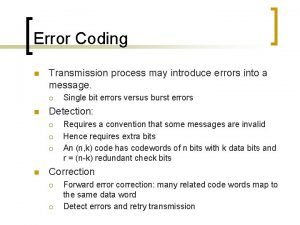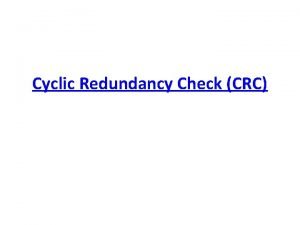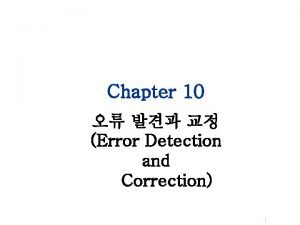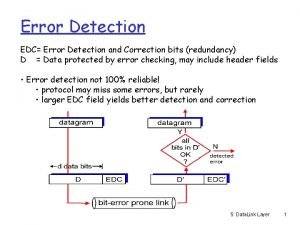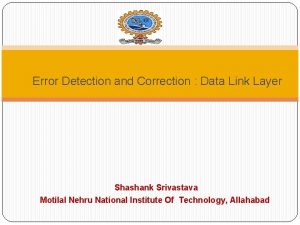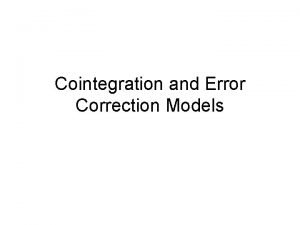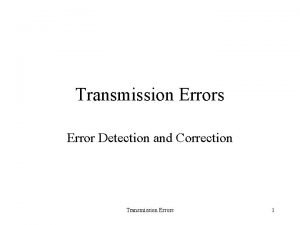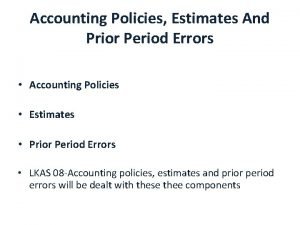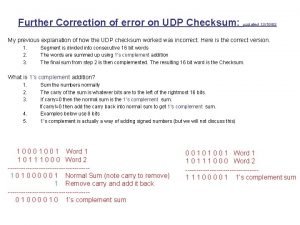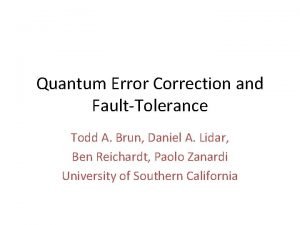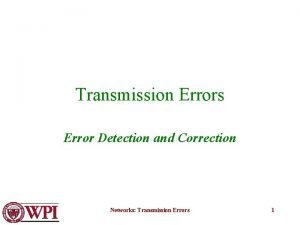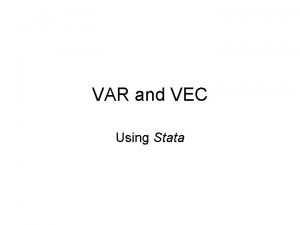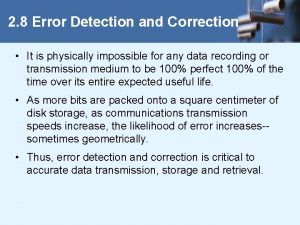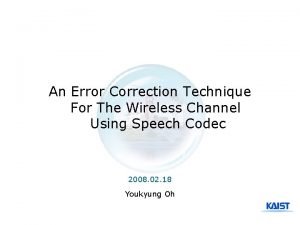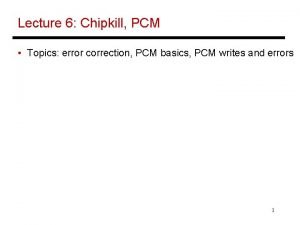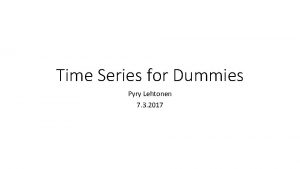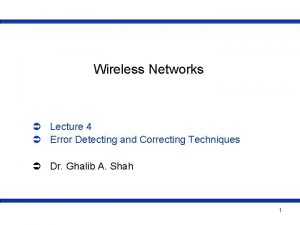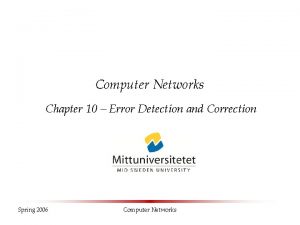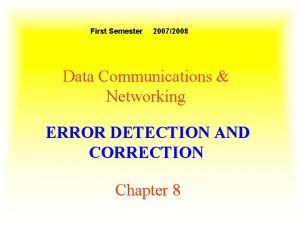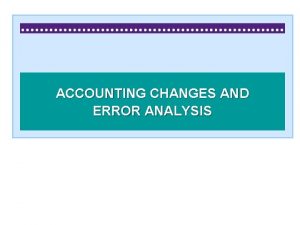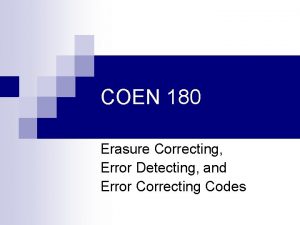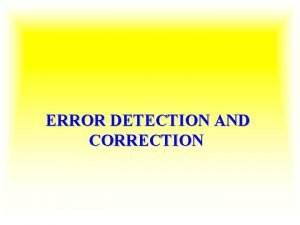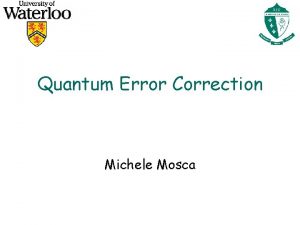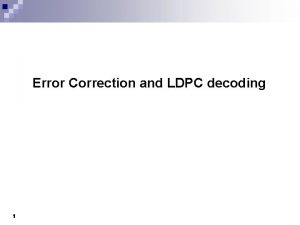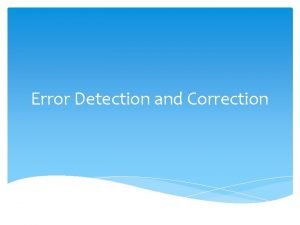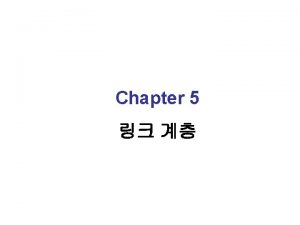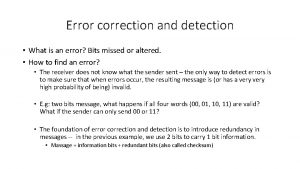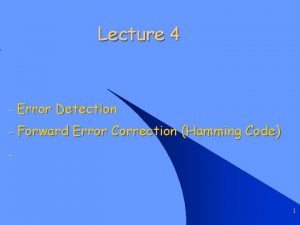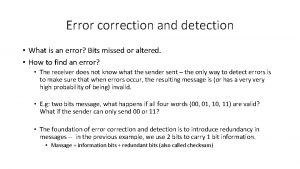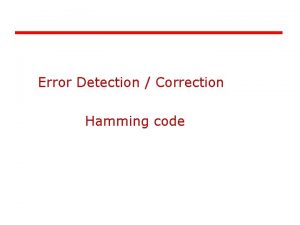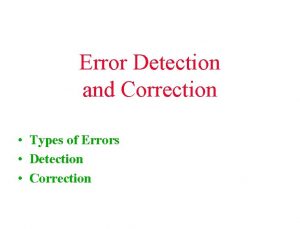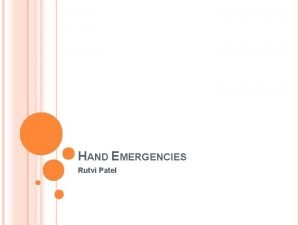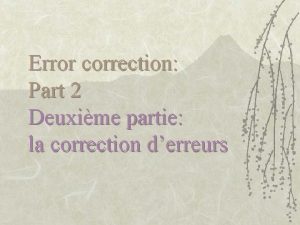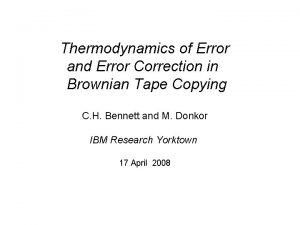ERROR CORRECTION ERROR DETECTION Rutvi Shah 1 n
































- Slides: 32

ERROR CORRECTION & ERROR DETECTION Rutvi Shah 1

n n Data can be corrupted during transmission. For reliable communication, errors must be detected and corrected. Error detection and correction are implemented either at data link layer or the transport layer of the OSI model. Rutvi Shah 2

TYPES OF ERRORS n n Single bit error : - Only one bit in the data unit has changed. Burst error : - It means that two or more bits in the data unit has changed. Rutvi Shah 3

Single bit Error 0 changed to 1 0 0 0 0 1 0 Received Sent Burst Error 0 1 0 0 1 1 Bits corrupted by Burst Error 0 1 1 1 0 1 0 0 1 1 Received Rutvi Shah 4

ERROR DETECTION n n Error detecting code is to include only enough redundancy to allow the receiver to deduce that an error occurred, but not which error, and have it request a retransmission. Error detection uses the concept of redundancy, which means adding extra bits for detecting error at the destination. Rutvi Shah 5

Redundancy n Instead of repeating the entire data stream, a shorter group of bits may be appended to the end of each unit. This technique is called Redundancy because the extra bit are redundant to the information. They are discarded as soon as the accuracy of the transmission has been determined. Rutvi Shah 6

Rutvi Shah 7

n There are basically four types of redundancy checks. They are: 1. VRC (Vertical Redundancy Check). 2. LRC (Longitudinal Redundancy Check). 3. CRC (Cyclical Redundancy Check). Rutvi Shah 8

ERROR DETECTION n VERTICAL REDUNDUNCY CHECK n LONGITUDINAL REDUNDANCY CHECK n CYCLIC REDUNDANCY CHECK Rutvi Shah 9

VERTICAL REDUNDANCY CHECK It is also known as parity check It is least expensive mechanism for error detection In this technique, the redundant bit called parity bit is appended to every data unit so that the total number of 1 s in the unit becomes even (including parity bit) Rutvi Shah 10

VERTICAL REDUNDANCY CHECK 1100001 Checking function Is total number of 1 s even ? 1100001 | 1 Receiver Data Even – parity generator 1 VRC Sender Rutvi Shah 11

VERTICAL REDUNDANCY CHECK n Example : 1110110 1101111 1110010 - After adding the parity bit 111011011110 Rutvi Shah 11100100 12

VERTICAL REDUNDANCY CHECK n n n VRC can detect all single – bit errors It can detect burst errors if the total number of errors in each data unit is odd. VRC can not detect errors where the total number of bits changed is even. Rutvi Shah 13

LONGITUDINAL REDUNDANCY CHECK(LRC) In this method , a block of bits is organized in table(rows and columns) calculate the parity bit for each column and the set of this parity bit is also sending with original data. From the block of parity we can check the redundancy. Rutvi Shah 14

LRC Example 11100111 11011101 00111001 10101001 LRC 1010 11100111 1101101 00111001 10101010 Original data plus LRC Rutvi Shah 15

LRC Example Suppose the following block is sent : 10101001 00111001 1101 11100111 1010 (LRC) However, it is hit by burst of length eight and some bits are corrupted (Yellow bits are changed) : 10100011 10001001 1101 11100111 1010 (LRC) When the receiver checks the LRC, some of the bits are not follow even parity rule and whole block is discarded (the non matching bits are shown in red ) : 10100011 10001001 1101 11100111 1010 Rutvi Shah 16

Advantage : -> LRC of n bits can easily detect burst error of n bits. Disadvantage : -> If two bits in one data units are damaged and two bits in exactly same position in another data unit are also damaged , the LRC checker will not detect the error. Rutvi Shah 17

CYCLIC REDUNDANCY CHECK (CRC) n In this method , a sequence of redundant bits , called the CRC or the CRC remainder, is appended to the end of the unit so that the resulting data unit become exactly divisible by a second, predetermined binary number. At its destination , the incoming data unit is divided by the same number. If at this step there is no remainder , the data unit assume to be correct and is accepted, otherwise it indicate that data unit has been damaged in transmission and therefore must be rejected. The redundancy bits is used by CRC are derived by dividing the data unit by a predetermined divisor. The remainder is the CRC. Rutvi Shah 18

n CRC generator and checker DATA CRC DATA 00… 0 N bits DIVISOR DATA CRC DIVIS 0 R N+1 bits REMAINDER Zero accept CRC N bits Nonzero reject Receiver Rutvi Shah Sender 19

Divisor The divisor is determined according to the algebraic polynomial. for e. g. A polynomial is X^7 + x^5 + x^2 + x +1 generation of divisor from polynomial X^7 + X^5 + X^2 + X + 1 X^6 1 0 X^4 X^3 1 0 0 Rutvi Shah 1 1 1 20

A polynomial should be selected according to the following rule: 1. It should not be divisible by x. 2. It should be divisible by x+1. Rutvi Shah 21

n n Example : The CRC generator at sender end : 111101 100100 0 1101 1000 1101 1010 1101 1110 1101 0110 0000 1101 Rutvi 0 Shah 01 22

The CRC checker at receiver end : 111101 100100 0 0 1 1101 1000 1101 1010 1101 1110 1101 0110 0000 1101 Rutvi Shah 000 23

ERROR CORRECTION n n Error correcting code is to include enough redundant information along with each block of data sent to enable the receiver to deduce what the transmitted character must have been. Error Correction must be handled in two ways : - When an error is discovered, the receiver can have the sender retransmit the entire data unit. - Receiver can use an error correcting code, which automatically corrects certain errors. Rutvi Shah 24

n There are two types of Error Correcting techniques : 1. Single bit error correction. 2. Burst error correction. n Error Correction can be done with the help of HAMMING CODE. Rutvi Shah 25

HAMMING CODE n n It is a technique developed by R. W. Hamming code can be applied to data units of any length and uses the relationship between data and redundancy bits. For eg. Rutvi Shah 26

n n A 7 bit ASCII code requires 4 Redundancy bits that can be added to the end of the data unit or interspersed with the original data bits. These bits are placed in positions 1, 2, 4 and 8. We refer to these bits as r 1, r 2, r 4 and r 8. Rutvi Shah 27

Positions of Redundancy Bits in Hamming Code 11 10 9 d d d 8 r 7 6 5 4 3 d d d r d 2 r 1 r Redundancy Bits Rutvi Shah 28

n n In the Hamming code, each r bit is the VRC bit for one combination of data bits : - r 1 is the one combination of data bits. - r 2 is another combination of data bits. and so on. The combination used to calculate each of the four values for a 7 bit data sequence are as follows : - r 1 : bits 1, 3, 5, 7, 9, 11. - r 2 : bits 2, 3, 6, 7, 10, 11. - r 4 : bits 4, 5, 6, 7. - r 8 : bits 8, 9, 10, 11. Rutvi Shah 29

Data : 1 0 0 1 1 0 1 Data 1 0 0 1 1 0 1 Adding r 1 1 0 0 1 1 0 1 Adding r 2 1 0 0 1 1 0 0 1 Adding r 4 Adding r 8 1 0 1 1 0 0 1 0 1 11 10 9 8 7 6 5 4 3 Rutvi Shah Code : 10011100101 2 1 30

1 0 0 1 1 1 0 0 1 0 1 Sent Error 1 0 0 1 Rutvi Shah Received 31

1 0 0 1 0 1 0 0 1 0 1 11 10 9 8 7 6 5 4 3 2 1 The bit in position 7 is in error Rutvi Shah 0 1 1 1 32
 Difference between error detection and error correction
Difference between error detection and error correction Cyclic redundancy check
Cyclic redundancy check Crc error detection
Crc error detection Error detection code
Error detection code Error detection in computer networks
Error detection in computer networks Edc error
Edc error Error detection and correction in data link layer
Error detection and correction in data link layer What is crc in computer network
What is crc in computer network Cointegration and error correction model
Cointegration and error correction model Error correction code
Error correction code Correction of error
Correction of error Iso good documentation practices
Iso good documentation practices Correction of prior period error
Correction of prior period error Udp checksum error detection
Udp checksum error detection Quantum error correction
Quantum error correction Transmission errors
Transmission errors Vec stata
Vec stata Hamming code error detection
Hamming code error detection Wifi error correction
Wifi error correction Partial adjustment model
Partial adjustment model Chipkill
Chipkill Error correction adalah
Error correction adalah Time series for dummies
Time series for dummies 4 step error correction procedure pecs
4 step error correction procedure pecs Two dimensional parity check
Two dimensional parity check Alcoac
Alcoac Crc in computer networks
Crc in computer networks N 10101001
N 10101001 Correction of errors in accounting questions
Correction of errors in accounting questions Error detection methods
Error detection methods Slide error in accounting
Slide error in accounting Diff between trading account and profit and loss account
Diff between trading account and profit and loss account Crc error detection
Crc error detection
